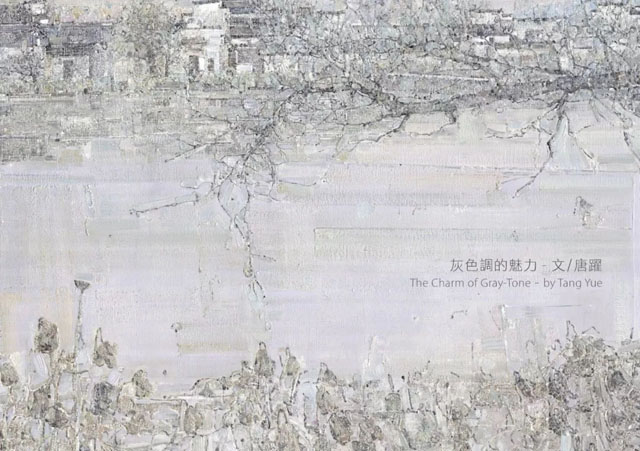
灰色调的魅力
唐 跃/安徽省文联副主席
有一种感觉,郭凯的油画越画越灰了。
我没有接触过上个世纪的郭凯,只是很有限地接触到他早先的作品,比如1993年到婺源晓起后的创作和1996年在中央美院进修期间的创作。按照殷双喜先生的说法,郭凯那时的作品用色厚重,有些拘谨和过于理性。但是,没过多久,他的用色感性起来,逐渐走向平淡走向松弛。这个转变,也就是越画越灰的过程。
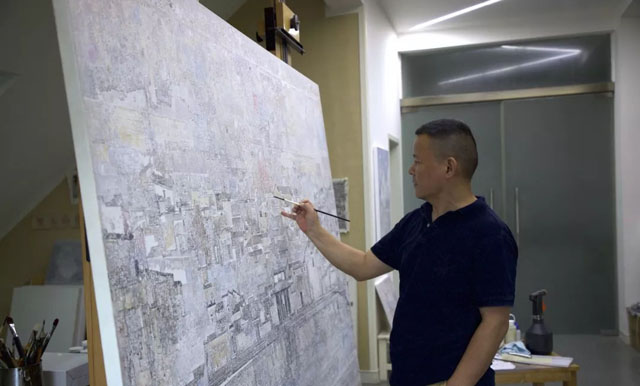
说是越画越灰,其实是指郭凯对于灰色的掌控越来越得心应手。郭凯早年的厚重和拘谨只是相对后来的轻盈和从容,他的用色没有遵循写实原则和客观物象的色彩属性。如《晓起》,画面色相是灰性的,是低明度和低纯度的,瀰漫着静谧的气氛和迷蒙的趣味。不过,从形而下的灰色运用转向形而上的灰色调表现,用灰色调大幅笼罩画面,造就了如梦如幻、如泣如诉的诗意质量,是21世纪以来的事情。
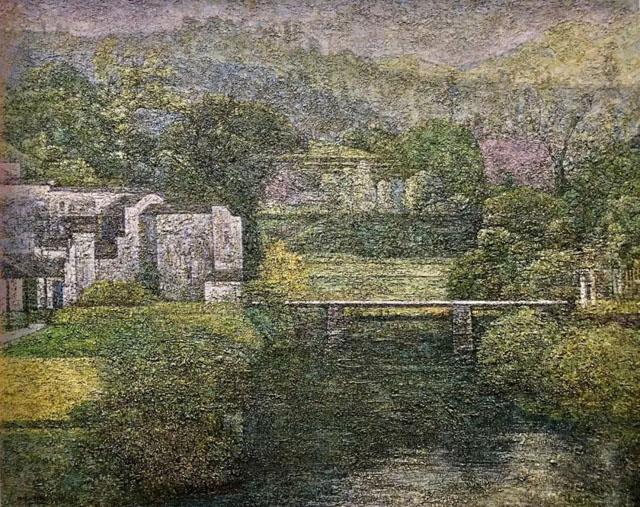
曉起 Xiaoqi
1998, 120 x 150 cm
油彩布面 Oil on Canvas
形而下的灰色運用,是指把灰色作為多種色彩中的一種,參與描繪物件的形體塑造;甚至在畫面上用以表現明暗對比,在結構關係上發揮過渡和轉折的作用,或用以表現冷暖對比和補色效果,降低色彩的明度和純度,在色彩關係上發揮協調和融合作用。此時的灰色運用仍然帶有工具的性質,雖然不再滿足於扮演塑造某個形體的灰色面的角色,卻還是作為一種色彩參與著畫面造型。20世紀的郭凱在用色上處於摸索階段,並不拘泥於寫實,也沒有達到主觀化色彩的高度自覺。那時的灰色運用頗有些半推半就,一方面對作品的調性、趣味發生影響,就像1993年第一次前往曉起的創作;另一方面,服務於形體塑造的灰色塊面依然清晰可見,就像1996年在中央美院進修期間所畫的皖南民居。21世紀以來,郭凱開始追求灰色的本質的、內在的東西,使灰色成為負載著畫家精神和情感的色彩語言,成為了一種調性,一種意味,一種象徵。如此一來,形而上的或者說主觀表現性的「灰色調」應運而生。
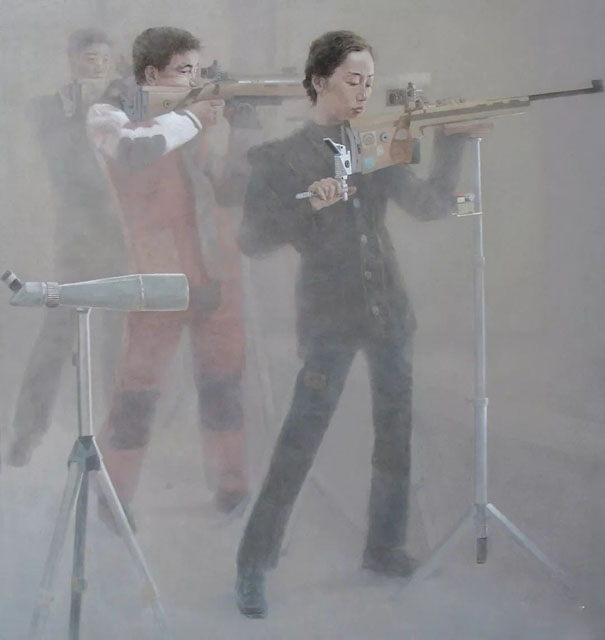
心繫靶心之一 Eye of the Target I
2005, 180 x 170 cm
油彩布面 Oil on Canvas
早先在用色上處於摸索階段,表明郭凱找尋前行方向:盯上了皖南民居,對於表現題材已然心中有數,然而,究竟鋪設怎樣的精神底色,或營造怎樣的情感氛圍,採納怎樣的表現方法和建構怎樣的表現系統,似乎沒有完全想好,所以設色語言尚嫌猶疑、糾結。後來郭凱決心用灰色調統領畫面,應該來自兩方面的原因,一是他原本就偏愛灰色的沉著和淡定,例如兩幅《心繫系靶心》都以大面積的灰色鋪底,並感染著包括紅色的其他色彩,這固然有利於表現「沉靜中的力量與技術」,表現人物在瞄準靶心時的堅毅狀態,但還是多少缺失了百步穿楊的激情和彈無虛發的憧憬。二是,也是更重要的,郭凱經過一段摸索,對灰色的認識更深刻,領悟到灰色的包容性和張力。灰色看上去很中性、平和,遊走於黑白之間,顯得很空靈,在捉摸不定中潛在著寧靜致遠的力量。所以當郭凱用複雜的心緒打探皖南風景時,灰色便成為首選。2010年前後,郭凱醞釀已久的這種表達漸趨穩定和成熟,諸如《松霜雪意》、《輕風隨影》、《遠嶺松聲》等,整個畫面被灰色籠罩,近乎天地初開,混沌一氣,引導觀者去追究遠山、古樹,以及山下樹邊的民居所在。畫面上雖然沒有人物,但畫者和觀者都藏在畫裡,都在與自然風景的對話中追尋著心靈棲息地的彼岸。
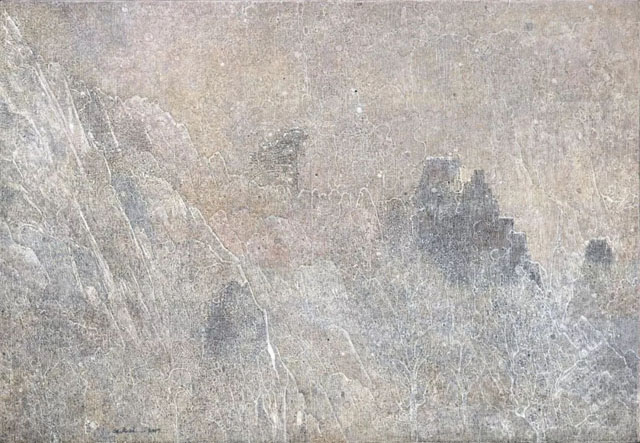
幽谷雪霁 Snow in Secluded Valley
2017, 90 x 130 cm
油彩布面 Oil on Canvas
我没问过郭凯,他的创作是否受过乔治.莫兰迪的影响,这位来自意大利的灰色调大师善于把蓝、橙、土黄等不同色彩渗入灰色里,证明自己对于灰色卓越的驾驭力。莫兰迪一生孤寂而平凡,厮守着生活中的坛坛罐罐,因为灰色调的运用,所有静物置放都达到视觉上的完美平衡,给人安静、温柔、体贴的精神慰藉,传递出宁静和隐秘的气息。郭凯同样让诸多色彩淡化在灰色里,失却各自的明亮度,离异各自的纯净度,形成安逸而有些间隔的图式,成全静谧而带有遐想的画境,造就有形与无形交织、有声与无声互融的皖南民居的诗意之美。郭凯的油画,不张不扬,不惊不乍,默默释放出最朴实的震撼力和直逼内心的优雅。例如《秋木远声》,青砖黛瓦马头墙在灰色中若隐若现,不再黑白分明;秋天环绕民居的高低参差、远近错落的树木原本色彩鲜明,却在灰化过程中成为灰绿、灰黄和灰红的组合,不再五彩斑斓。
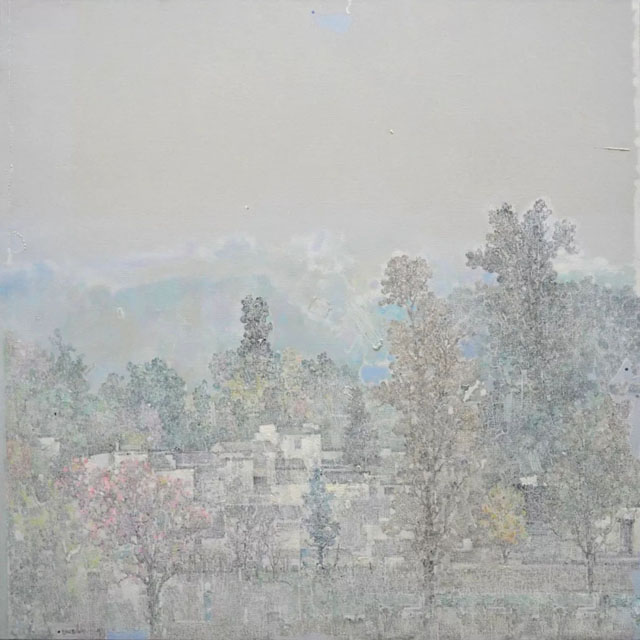
秋木远声 Distant Sounds in Autumn Woods
2013, 100 x 100 cm
油彩布面 Oil on Canvas
郭凯的画作透视出灰色调的理念、放射出灰色调的魅力,因此被诸多评论为最能体现中国画的审美追求。的确如此,当灰色调统领画面时,光的明暗、色的冷暖、视觉的远近变化等,不再成为组合作品时最重要的元素;形体关系的准确性、清晰度、质量感等,也不再成为评估作品时最突出的依据,而中国画品评框架里常见的写意思维,大幅提高了使用概率。有时,郭凯让灰色调与中国画的典型符号相遇、相知,使得解读起来刻意躲避国画品评语言而不能。如《幽潭泛舟》的一叶扁舟在幽深的水面上飘动,不知所之,让人联想到唐代张志和《渔歌子》以来的渔隐主题。有舟必然有人,却又看不清晰,小舟里传出的无声旋律,诉说着幽潭的空寂,与沉静的流水混合成天籁般的交响。另如《静碧闲荷》,仍然以灰色调为主,仍然是灰蒙蒙的村口水塘,大小的色阶稍有区别的色块零星散落水面,让人联想到八大、徐渭笔下的墨荷,散发着「出淤泥而不染,濯清涟而不妖」的幽香,然而,应该与灰色调有关,池塘上略嫌孤独和清高的卷荷,连同过于安静、近乎凝固的气流,在散发幽香的同时,感到几分疏离。
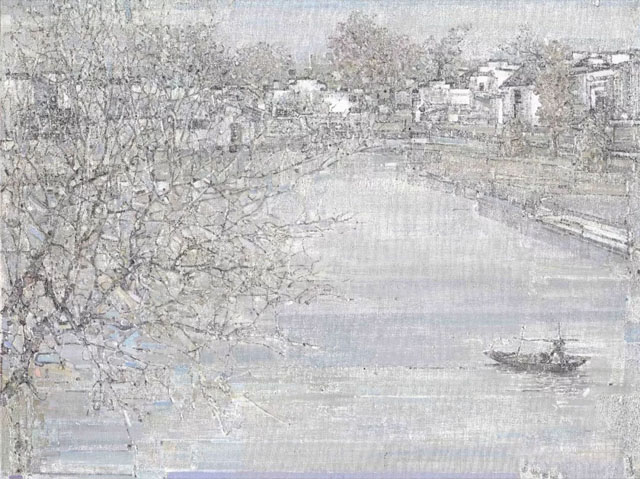
幽潭泛舟 Sailing on a Secluded Lake
2013, 90 x 120 cm
油彩布面 Oil on Canvas
灰色调是矛盾的统一体,一方面具有内涵丰富、启发想象的潜质,另一方面,表面上呈现出来雾气氤氲的单调感,需要画家运用精细的技术弥补。郭凯首先是思索肌理语言问题,在创作实践中长期探索肌理效果的变化,致力于画面质感的丰满,避免大面积涂抹灰色形成单调印象。例如《晨雾初开》、《萧疏山遥》等,粗看是灰色迷蒙,细看局部则可发现,与灰色相叠的材料纹理和笔触起伏痕迹纤毫毕露。郭凯曾经描述探索技术过程:「用松节油少量打底,皂化蜡增稠,混入矿物颜料及进口粗砂塑型剂等丰富画面表现,局部用刀做出柔和的浅起伏肌理,半干时用大笔营造关系,小号笔深入部分局部。」
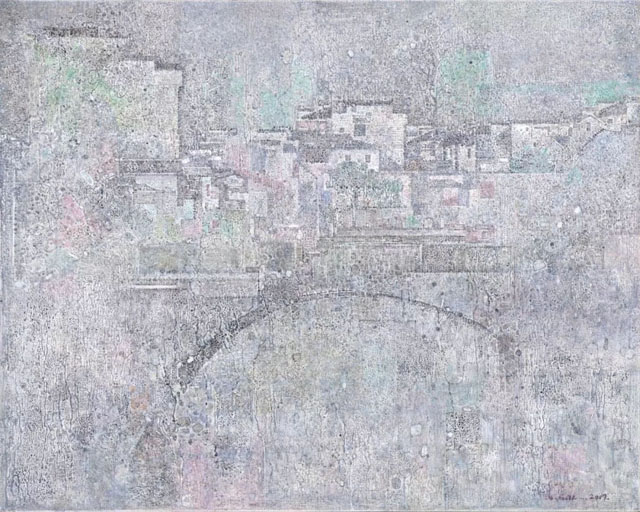
桥影NO.1 Reflection of the Bridge No. 1
2017, 80 x 100 cm
油彩布面 Oil on Canvas
2013年以后,郭凯色彩处理有些变化:灰色调仍旧统摄全域,但其他对比色的灰化程度减弱,亮度和纯度也有所提高。如《漫枝悄然》,铺底的大面积蓝色虽然灰灰的,但是不容混淆,映衬着黑白构成的树枝向四面八方伸展,迸发出不愿妥协的力量感。再如《檐边秋意》,红红黄黄的色彩没有淹没在灰色中,而以足够的亮度和纯度向人们招手,显示着果实满树,秋意正浓。又如《秋雾》,尽管是雾霭瀰漫的深秋,那些灿若桃花的粉红色,以及成熟花果枝叶的黄色和蓝色,已经冲破迷雾笼罩,展示生生不息的生命力。去年以来的新作表明,郭凯在丰富画面肌理和提高对比色的亮度、纯度同时出击,试图进一步制约整体灰色运用造成的间隔效果,强化灰色调的观赏性。就像《秋宅》、《白桥NO.2》等,多样鲜活的色彩成为参与肌理变化的抽象语言,在灰色布局上跳动闪烁,把画面装点得更加生动。
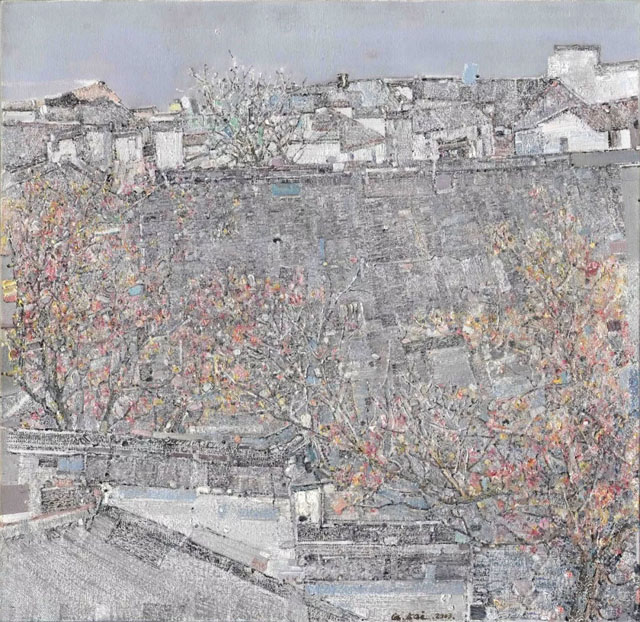
檐边秋意 Autumn by the Eaves
2013, 75 x 75 cm
油彩布面 Oil on Canvas
我以灰色的运用为线索,对郭凯的油画创作进行两阶段梳理,从形而下的灰色块到形而上的灰色调,又从灰色调的初级版到灰色调的升华版。郭凯接下去会怎样更有力地启动灰色的灵性,拓展灰色的包容空间和表现力,值得关注并寄予厚望!
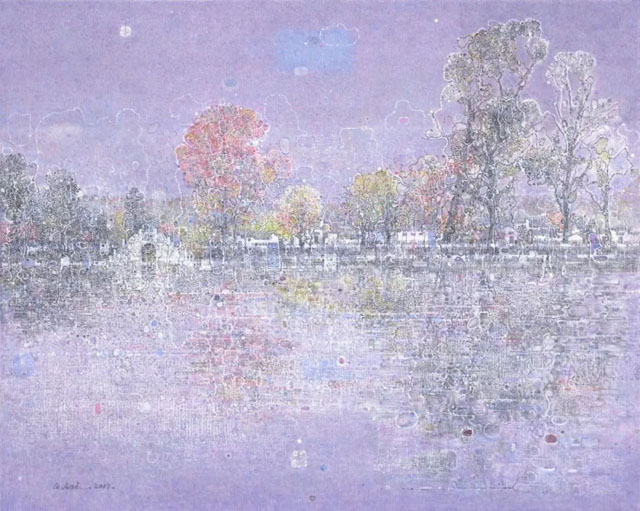
白桥NO.2 White Bridge No. 2
2017, 80 x 100 cm
油彩布面 Oil on Canvas
The Charm of Gray-Tone
Tang Yue/ Vice-President of CFLAC of Anhui Province
I have a feeling that Guo Kai’s paintings have become increasingly gray-toned.
I have not had the pleasure of knowing the Guo Kai of the last century, and have only a limited knowledge of his early works, such as works from Xiaoqi Village of Wuyuan County in 1993 and works created during his study at the China Central Academy of Fine Arts (CAFA) in 1996. According Yin Shuangxi’s assessment, Guo Kai’s works at that time were heavy in the use of color, and somewhat restrained and overly rational.
In terms of becoming increasingly gray-toned, it is in fact due to Guo Kai’s use of the color gray becoming executed with more control and freedom. The heavy use of color and restrained nature of Guo’s early works contrasts with the lightness and ease of his later works, but his use of color has never strictly followed the principles of Realism. For example, in Xiaoqi Village of 1993, the image is gray is tone, with a low sense of light and clarity, and filled with a quiet atmosphere. However, Guo Kai’s paintings have gone from a physical use of gray to a spiritual gray-tone expression. The use of gray-tone over an entire image creates a dreamlike and poetic quality, and is a matter of the Twenty-First Century for the artist.
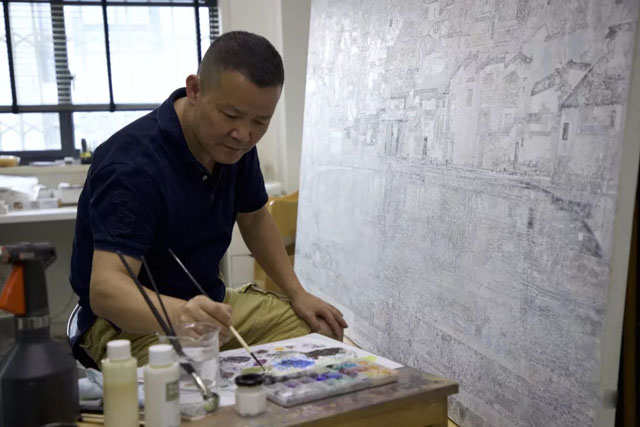
The physical use of gray refers its use among a variety of colors, to illustrate the physical shape of an object. Furthermore, it is used in the contrast between light and dark. In terms of composition, it plays a role in the transition of colors, or in the contrast between cold and warm tones. This use of gray is still a technical matter. Although it has taken on a greater role than simply shading, it is nonetheless a pictorial device. The Guo Kai of the Twentieth Century was in period of exploration, not rigidly adhering to Realsim, but not yet breaking into the grounds of a personal Subjectivism. During this period, Guo’s use of gray was incomplete. On one hand, it enhanced the sense of personal style, as seen in Dawnof1993, while on the other hand, its purpose as a device for rendering shapes and objects was still clear, like his works during his time at CAFA. Since the Twenty-First Century, Guo Kai began pursing the essence of gray, and its intrinsic value. For him, the color became an artistic language bearing the artist’s spirit and emotions. On a visual level, the color gradually grew into an overall tone, which dictated the composition as a whole. As a result, Guo’s use of gray became a spiritual use of subjective expressionism.
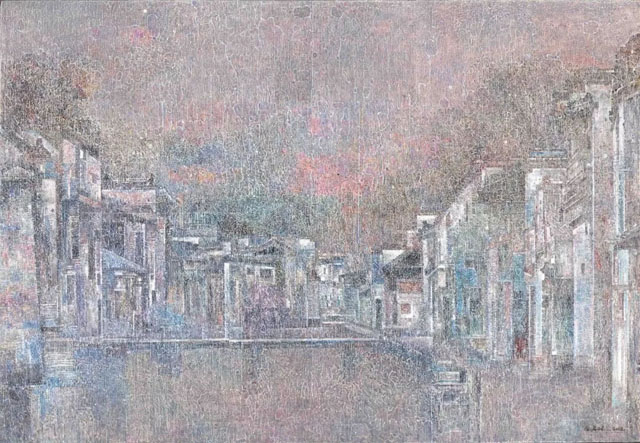
遠村如煙 Misty Remote Village
2018, 90 x 130 cm
油彩布面 Oil on Canvas
Guo Kai’s early period of exploration with different colors is an indication of his search for direction. In terms of subject matter, Guo is already familiar with the historic buildings of southern Anhui Province. However, in representation, such as setting the color scheme, creating the emotional atmosphere, and choosing the mode of illustrating architecture, he displayed signs of uncertainty. Guo’s later decision and dedication to the gray-toned image is due to two reasons. Firstly, he had already developed a preference for the calm and composed nature of gray. In the Eye of the Target series, the background is largely set in gray, with a limited use of other colors, which symbolizes the mental composure and concentration of the archers when aiming at the target. However, the brighter treatment of colors on the figures seems to disconnect them from the gray background, in which a sense of compositional unity is lost. Secondly, and more importantly, after a period of exploration, Guo Kai has developed a deeper understanding of gray, especially the neutrality of the color. Existing between the extremes of black and white, gray reserves a certain degree of potential and uncertainty. Therefore, when Guo Kai faces the landscape of southern Anhui with personal thoughts and emotions, gray is the color of choice. Around 2010, Guo Kai’s style finally reached maturity. In Frosty Pines, Breezy Shadows, and Distant Sound of Pine, the surfaces of each painting appear to be covered in a sheet of gray. The overall tone is calm and composed, and allows the viewer to carefully search through the painting for old trees, distant mountains, and the villages nestled within. Although the image is with human figures, both the artist and viewer are invited into the painting, to converse with the natural scenery.
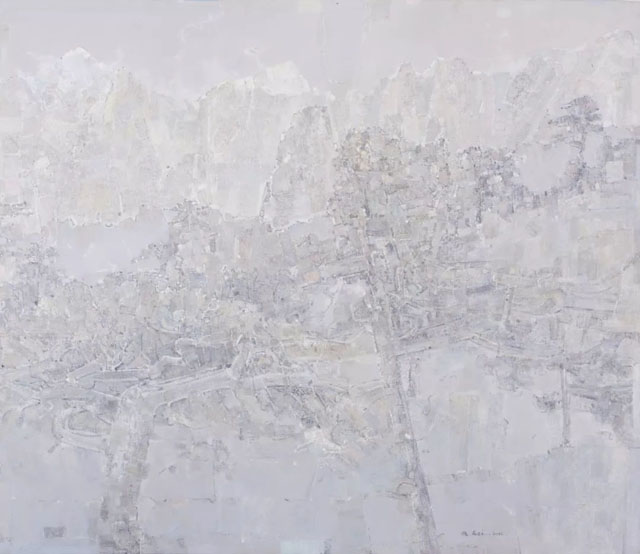
遠嶺松聲 The Sound of Pine from a Distant Ridge
2014, 130 x 150 cm
油彩布面 Oil on Canvas
I have not asked Guo Kai, if his art has been influenced by Giorgio Morandi (1894 - 1964), the Italian painter, who brilliantly mixes blue, orange, and beige into his gray compositions. Morandi led an ordinary and lonely life, and painted exclusively still life paintings of bottles. Because of his use of gray, Morandi’s still life paintings gave a sense of calmness, warmth, and comfort. Similarly, Guo Kai also mixes muted colors into his gray. Leaving behind the brightness and the distinctness of individual colors, Guo achieves harmonious distribution of colors within an overall spectrum of gray. Without strong colors to outline the contours of figures, the subjects within his paintings linger between figurative form and formless abstraction, as poetic allusions to the scenery in which they exist. Seemingly bland at first sight, the emotional depths of Guo Kai’s paintings are revealed subtly and quietly. In Distant Sounds in Autumn Woods, the tiles of the sloping roof of the building are hidden in a sea of gray, and are one with its natural surroundings. The bright autumn colors of the trees are diluted in the gray-tone, becoming pale greens and yellows.
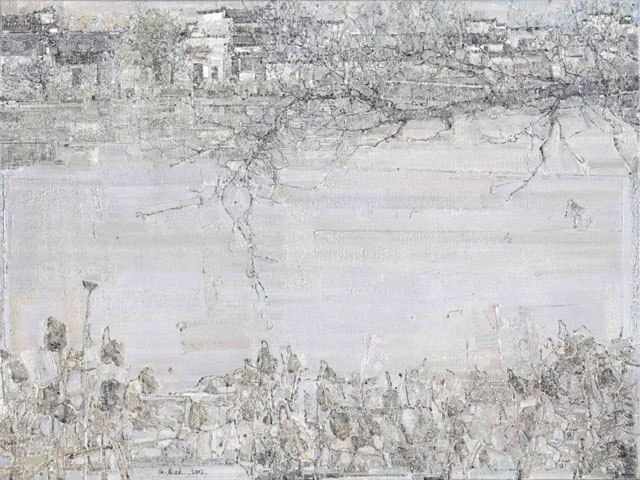
靜碧閒荷 Tranquil Lotus Bed
2013, 90 x 120 cm
油彩布面 Oil on Canvas
Guo Kai’s art expresses the philosophy and charm of the gray-tone, and has therefore been understood as a search for traditional Chinese aesthetics. Indeed, when gray-tone dominate an image, the value of light, the warmth of colors, the use of perspective, are no longer the most important elements in the composition, and the accurate rendering of physical shapes, in terms of figurative representation, is no longer the most determine factor in assessing an artwork. In the framework of traditional Chinese painting, the emotion conveyed is most valued. Many traditional Chinese painting motifs can be found in Guo Kai’s paintings, in which they hold the same symbolism as in the traditional canon. Therefore in appreciating his art, a traditional approach is not without merit. In Sailing on a Secluded Lake, a small boat is depicted on a lake, which is reminiscent of the traditional motif of a fisherman, which symbolizes reclusion and freedom from the mundane nature of daily life. Although the boat is present, the presence of the fisherman is only implied. The boat itself is without action or movement, completely still inside the painting. In Tranquil Lotus Bed, also set in gray-tone, the subject is a lotus pound in front of a rural village. The limited use of colors on the withered lotus brings to mind the famous ink renditions of lotus by Bada Shanren (1626 - 1705), in which different tonalities of ink and wash fully and vividly render the elegant shape of the leaves.
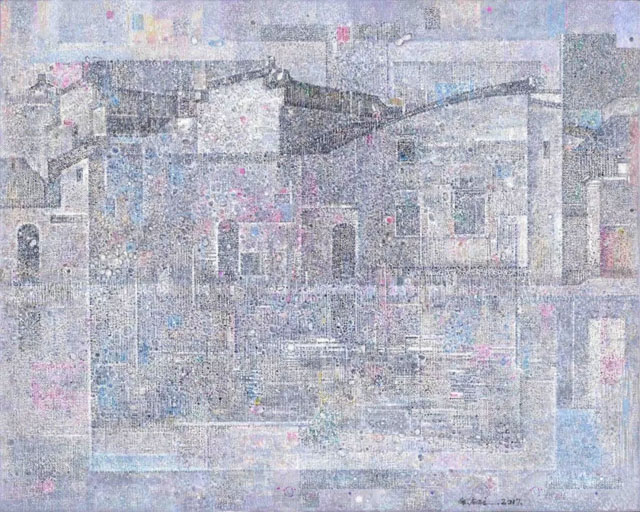
宅構 Homestead
2007, 80 x 100 cm
油彩布面 Oil on Canvas
Gray monochrome itself is a contradiction, in the sense that, on one hand, the neutrality of the color is full of visual potential and leaves room to the imagination, while on the other hand; the bland and monotonous nature of the color truly demands the talent of the artist. Firstly, Guo Kai is concerned with the surface texture of the painting, and has long explored the various applications of texture. His goal is to create sculptural qualities to his painted canvas, while avoiding smearing excess paint in a crude fashion. A close inspection of Early Morning Mist and Distant Mountain reveals faint sculptural patterns in the gray paint, in which the movements of the brush can be detected. Guo Kai has described his practice of “making a light base with turpentine, and mixing with saponified wax, color pigment, and molding paste for the paint. In certain parts, the painter’s knife sculpts the applied paint before it has completely dried.”
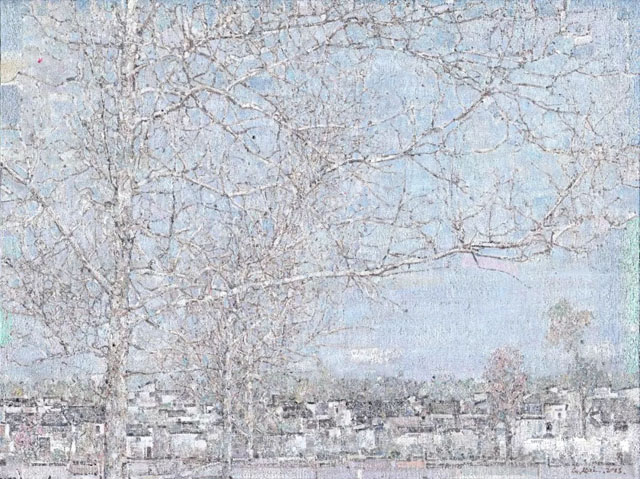
漫枝悄然 Blooming Branches
2013, 90 x 120 cm
油彩布面 Oil on Canvas
Since 2013, Guo Kai’s use of colors when through another change. While gray dominates the overall composition, his other colors are less diluted by gray and have retained their brightness and individuality. In Blooming Branches, the background is largely set in a bluish-gray, but it does not conflict with the crisscrossing black and white branches of the foreground, instead it reinforces the vitality of the branches. In Autumn by the Eaves, the autumn colors of red and yellow are not submerged within the gray, but instead stand out to the viewer, strongly signifying the mood of the season. Also in Autumn Mist, even in rainy and misty autumn weather, brightly colored leaves pierce through the fog, full of life. In his representative works form last year, the textures have taken a more sculptural quality and the complimentary colors have become brighter and more distinct, thereby bringing his paintings into a more advanced application and appreciation of the gray-tone. In Autumn Estate and White Bridge No. 2, the brighter colors have taken on a more abstract quality in the image, seemingly floating above the gray composition with a sense of excitement and movement.

秋宅 Autumn Estate
2016, 30 x 40 cm x 2
油彩布面 Oil on Canvas
Taking the use of gray-tone as an approach, Guo Kai’s art is analyzed from two stages, from a pictorial use of the color to a more spiritual use, and also from an early period of exploration to a mature and developed style. Where Guo Kai will take this use of gray, in terms of the colors neutrality and expressiveness, is worth considering and waiting for.
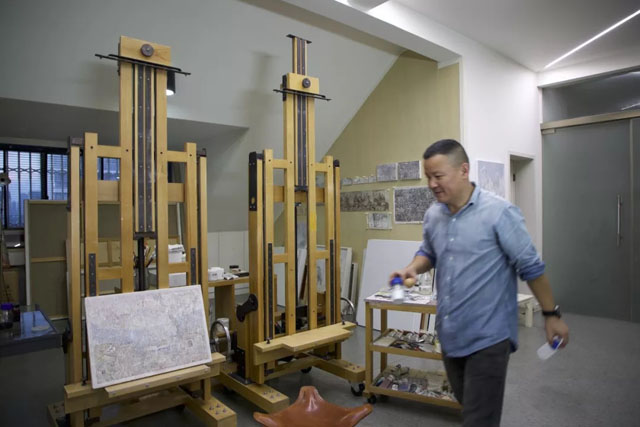
郭 凱 - 清風遠逸
國父紀念館個展
GUO KAI - Faraway Breeze
Solo Exhibition at Sun Yat-sen Memorial Hall
展覽日期 Date: 2018.9.15 - 24
開幕時間 Reception: 2018.9.15 週六 Sat 3:00 pm
開放時間 Hours: 9:00 am - 6:00 pm
展出地點 Venue: 國父紀念館 文華軒(二樓川堂)
- 台北市信義區仁愛路四段五零五號
Wenhua Gallery, 2F, Sun Yat-sen Memorial Hall
- No 505, Sec 4, Renai Rd, Xinyi Dist, Taipei





 皖公网安备 34010402700602号
皖公网安备 34010402700602号